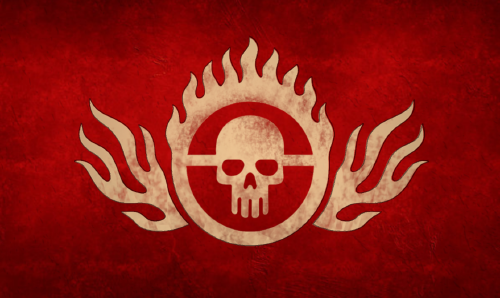| National Factbook |
| Flag: |

|
| Nation Name: |
Legion of Mad Fellows |
| Leader Name: |
Number 9 Man |
| Currency: |

Bitcoin |
| National Animal: |

Pingu |
| History: |
Bosnia and Herzegovina is a unique federal state with no dominant ethnic group, as was the case in other constituent states, all of which were also nation states of Yugoslavia's South Slavic ethnic groups. It was administered under strict terms of sanctioned consociationalism, known locally as "ethnic key" or "national key" (Serbo-Croatian: etnički ključ / етнички кључ, nacionalni ključ / национални кључ), based on the balance of political representation of 3 largest ethnic groups (Bosnian Muslims,[a] Croats and Serbs). Sarajevo served as the capital city throughout its existence and remained the capital following independence. The Socialist Republic was dissolved in 1990 when it abandoned its socialist institutions and adopted liberal ones, as the Republic of Bosnia and Herzegovina which declared independence from Yugoslavia in 1992. The Government of Bosnia and Herzegovina was, up to 20 December 1990, in sole control of the League of Communists of Bosnia and Herzegovina, the Bosnian branch of League of Communists of Yugoslavia. The borders of SR Bosnia and Herzegovina were almost identical to the one Condominium of Bosnia and Herzegovina had during the period of Austro-Hungarian rule that lasted until 1918. That year Bosnia became part of the Kingdom of Serbs, Croats, and Slovenes and divided into several banovinas (regional administrative units), namely parts of Vrbas, Drina, Zeta and Croatia banovinas. With the establishment of a People's Republic, its modern borders were delineated. |
| Geography |
| Continent: |
Australia |
| Land Area: |
232,549.63 sq. km |
| Terrain: |
Bosnia and Herzegovina has a largely mountainous terrain. The Dinaric Alps dominate the western border with Croatia, and numerous ranges, including the Kozara, Vlašic, Plješevica, Grmeč, Cincar, and Raduša, run through the country, generally in a northwest-southeast direction. The highest peak, reaching 7,828 feet (2,386 metres), is Maglić, near the border with Montenegro. In the south and southwest is the Karst, a region of arid limestone plateaus that contain caves, potholes, and underground drainage. The uplands there are often bare and denuded (the result of deforestation and thin soils), but, between the ridges, depressions known as poljes are covered with alluvial soil that is suitable for agriculture. Elevations of more than 6,000 feet (1,800 metres) are common, and the plateaus descend abruptly toward the Adriatic Sea. The coastline, limited to a length of 12 miles (20 km) along the Adriatic Sea, is bounded on both sides by Croatia and contains no natural harbours. In central Bosnia the rocks and soils are less vulnerable to erosion, and the terrain there is characterized by rugged but green and often forested plateaus. In the north, narrow lowlands extend along the Sava River and its tributaries. |
| Highest Peak: |
Maglić,
51 meters
|
| Lowest Valley: |
Adriatic Sea,
0 meters
|
| Climate: |
Although situated close to the Mediterranean Sea, Bosnia and Herzegovina is largely cut off from its climatic influence by the Dinaric Alps. The weather in the Bosnia region resembles that of the southern Austrian highlands—generally mild, though apt to be bitterly cold in winter. In Banja Luka the coldest month is January, with an average temperature of about 32 °F (0 °C), and the warmest month is July, which averages about 72 °F (22 °C). During January and February Banja Luka receives the least amount of precipitation, and in May and June it experiences the heaviest rainfall. Herzegovina has more affinity to the Croatian region of Dalmatia, which can be oppressively hot in summer. In Mostar, situated along the Neretva River, the coldest month is January, averaging about 42 °F (6 °C), and the warmest month is July, averaging about 78 °F (26 °C). Mostar experiences a relatively dry season from June to September. The remainder of the year is wet, with the heaviest precipitation between October and January. |
| People & Society |
| Population: |
13,524,333 people |
| Demonym: |
Bosnian |
| Demonym Plural: |
Bosnians |
| Ethnic Groups: |
Bosniak - 50.1%
Serbs - 30.8%
Croats - 15.4% |
| Languages: |
Bosnian - 50.1%
Serbian - 30.8%
Croatian - 15.4% |
| Religions: |
Islam - 51.0%
Christianity - 46.0%
Serbian Orthodox Church - 31.0% |
| Health |
| Life Expectancy: |
76 years |
| Obesity: |
20.3% |
| Alcohol Users: |
7.2% |
| Tobacco Users: |
41.1% |
| Cannabis Users: |
0.5% |
| Hard Drug Users: |
0.1% |
| Economy |
| Description: |
THE FUNDAMENTAL OBJECTIVES of Bosnian economic policy are to increase the national income and the volume of production in all branches of the economy by means of rapid economic development and a rise in labor productivity, which will provide a basis for improvement in the standard of living of the population. The achievement of these objectives is sought partly through government action and partly through the operation of the market mechanism. This combination, as such, is not unique. It exists in all countries where a government exercises some but not complete control over the economy. The peculiar features of the Yugoslav economic system derive from the fact that it limits private ownership of the means of production to small-scale production and trade (employing no more than five people plus the owner’s family) and to farms normally not exceeding 10 hectares in size, without for that reason resorting to government management. Under these conditions, some of the moving forces that shape the course of economic events in other market economies are either missing or largely inoperative, and government planning, being of the global type, does not provide the alternative that would allow the market mechanism to be superseded. The Yugoslav authorities are thus faced with the task of constructing a pattern of economic management that will be able to fill the gaps which would otherwise remain in the absence of detailed planning on the one hand and the nonexistence of certain free market forces on the other. |
| Average Yearly Income: |
$187.80 |
| Gross Domestic Product (GDP): |
$21,238,347,301.00 |
| GDP per Capita: |
$1,570.38 |
| Gross National Income (GNI): |
$14,539,489,935.00 |
| Industries: |
In addition to the role of the central authorities and of firms, the role of the lower government authorities and other decentralized institutions to whom some responsibilities of management have been assigned is by no means small. Yugoslavia is a federation of six autonomous republics, whose levels of productivity and per capita income show wide variations. There has to be a considerable delegation of responsibilities to the lower government authorities, while at the same time the efforts of these authorities have to be coordinated and the over-all economic objectives kept in view. The role of local authorities, especially of communes, is often indirect, being exerted through the representatives of the People’s Committee and the Council of Producers on the boards of various institutions and agencies that influence the conduct of firms or shape central government policy; another important function of the communes is to finance social overhead. At a higher administrative level, districts, and, still more, republics, have significant powers, notably with regard to investment. Trade associations, trade and industrial chambers, trade unions, local authorities, and various institutes, apart from having specific functional tasks, also cooperate with enterprises in the solution of common problems. They all form part of a system of “checks and balances,” under which each of the interested parties stresses some particular aspect of the problem under consideration, within the framework of a common political and social philosophy. Official supervision guards against such adverse tendencies as monopoly, prejudicial actions, unfair competition, and similar offenses. Both local government authorities and decentralized institutions have a special responsibility for initiating the establishment of new firms, whenever such initiative, although socially or economically desirable, is not forthcoming from an individual firm or a private citizen. |
| Military |
| History: |
Because of its central geographic position within the Bosnian federation, post-war Bosnia was strategically selected as a base for the development of the military defense industry.[1] This contributed to a large concentration of arms and military personnel in Bosnia; a significant factor in the war that followed the break-up of Yugoslavia in the 1990s. However, Bosnia's existence within Yugoslavia, for the large part, was peaceful and prosperous. Being one of the poorer republics in the early 1950s it quickly recovered economically, taking advantage of its extensive natural resources to stimulate industrial development. The Yugoslavian communist doctrine of "brotherhood and unity" particularly suited Bosnia's diverse and multi-ethnic society that, because of such an imposed system of tolerance, thrived culturally and socially. The improvements to cultural tolerance throughout Bosnia and Herzegovina culminated with the selection of Sarajevo to host the 1984 Winter Olympics. |
| Soldiers: |
0 |
| Tanks: |
23,275 |
| Aircraft: |
2,700 |
| Ships: |
0 |
| Missiles: |
0 |
| Nuclear Weapons: |
0 |
| Last Updated: 04/10/2023 01:40 am |
























